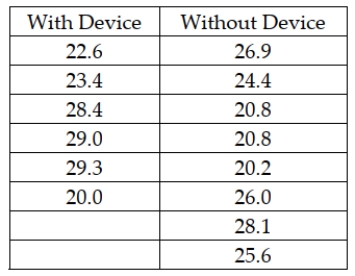Multiple Choice
A company in Maryland has developed a device that can be attached to car engines, which it believes will increase the miles per gallon that cars will get. The owners are interested in estimating the difference between mean mpg for cars using the device versus those that are not using the device. The following data represent the mpg for random independent samples of cars from each population. The variances are assumed equal and the populations normally distributed.  Given this data, what is the upper limit for a 95 percent confidence interval estimate for the difference in mean mpg?
Given this data, what is the upper limit for a 95 percent confidence interval estimate for the difference in mean mpg?
A) Approximately 3.88 mpg
B) About 5.44 mpg
C) Just under 25.0
D) None of the above
Correct Answer:

Verified
Correct Answer:
Verified
Q69: When conducting a hypothesis test to determine
Q70: When performing a hypothesis test for the
Q71: The American College Health Association produced the
Q72: The Cranston Hardware Company is interested in
Q73: The t-distribution can be used to test
Q75: The test statistic that is used when
Q76: Most companies that make golf balls and
Q77: An accounting firm has been hired by
Q78: A major retail clothing store is interested
Q79: The point estimate in a paired difference